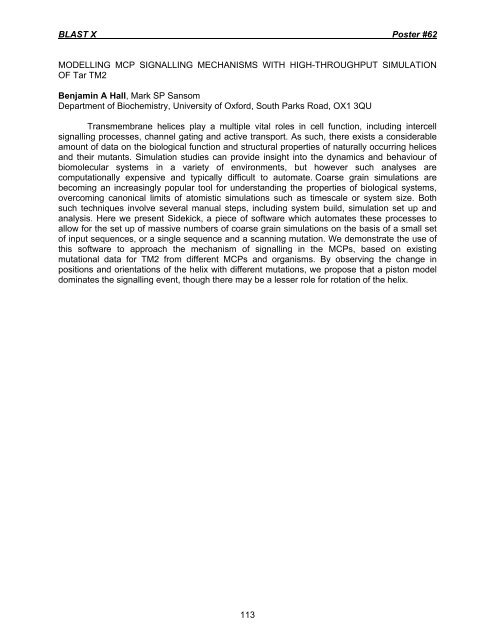POSTERS - BLAST X - University of Utah
POSTERS - BLAST X - University of Utah
POSTERS - BLAST X - University of Utah
Create successful ePaper yourself
Turn your PDF publications into a flip-book with our unique Google optimized e-Paper software.
<strong>BLAST</strong> X Poster #62<br />
MODELLING MCP SIGNALLING MECHANISMS WITH HIGH-THROUGHPUT SIMULATION<br />
OF Tar TM2<br />
Benjamin A Hall, Mark SP Sansom<br />
Department <strong>of</strong> Biochemistry, <strong>University</strong> <strong>of</strong> Oxford, South Parks Road, OX1 3QU<br />
Transmembrane helices play a multiple vital roles in cell function, including intercell<br />
signalling processes, channel gating and active transport. As such, there exists a considerable<br />
amount <strong>of</strong> data on the biological function and structural properties <strong>of</strong> naturally occurring helices<br />
and their mutants. Simulation studies can provide insight into the dynamics and behaviour <strong>of</strong><br />
biomolecular systems in a variety <strong>of</strong> environments, but however such analyses are<br />
computationally expensive and typically difficult to automate. Coarse grain simulations are<br />
becoming an increasingly popular tool for understanding the properties <strong>of</strong> biological systems,<br />
overcoming canonical limits <strong>of</strong> atomistic simulations such as timescale or system size. Both<br />
such techniques involve several manual steps, including system build, simulation set up and<br />
analysis. Here we present Sidekick, a piece <strong>of</strong> s<strong>of</strong>tware which automates these processes to<br />
allow for the set up <strong>of</strong> massive numbers <strong>of</strong> coarse grain simulations on the basis <strong>of</strong> a small set<br />
<strong>of</strong> input sequences, or a single sequence and a scanning mutation. We demonstrate the use <strong>of</strong><br />
this s<strong>of</strong>tware to approach the mechanism <strong>of</strong> signalling in the MCPs, based on existing<br />
mutational data for TM2 from different MCPs and organisms. By observing the change in<br />
positions and orientations <strong>of</strong> the helix with different mutations, we propose that a piston model<br />
dominates the signalling event, though there may be a lesser role for rotation <strong>of</strong> the helix.<br />
113


